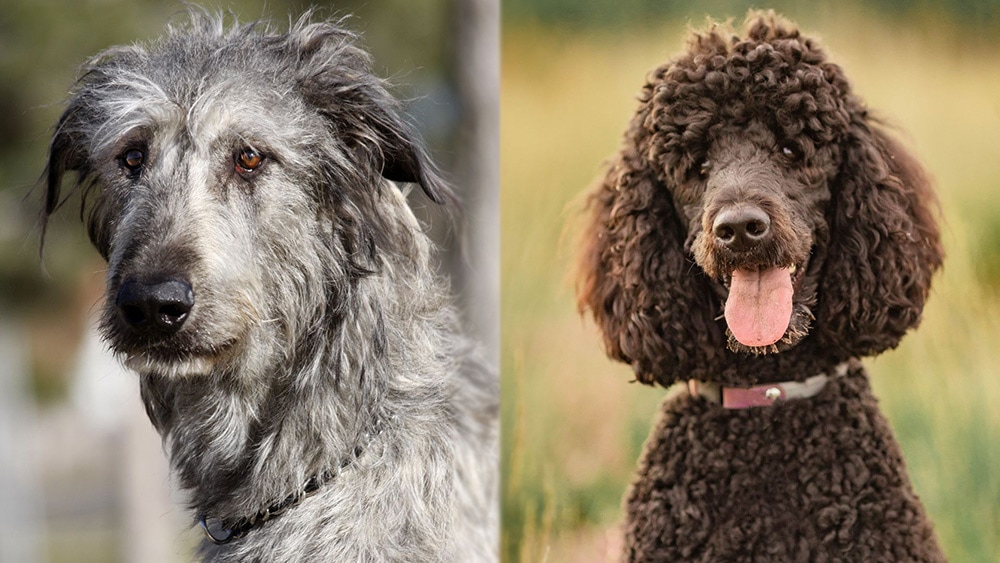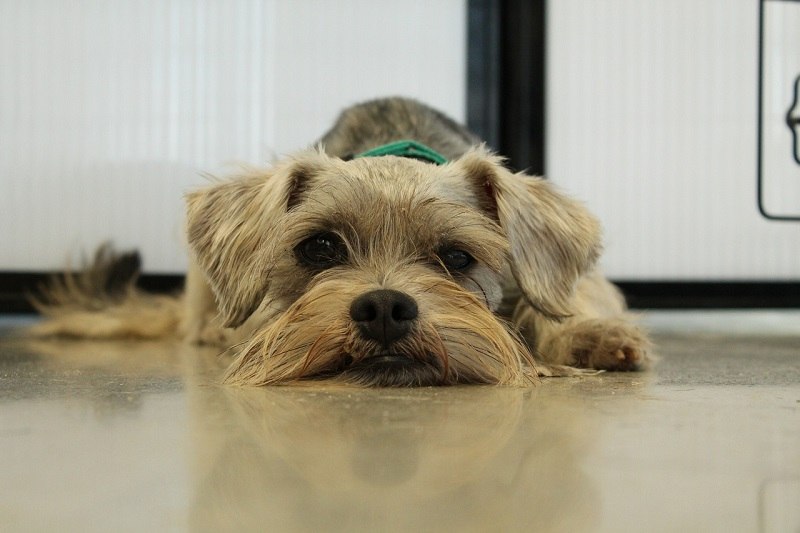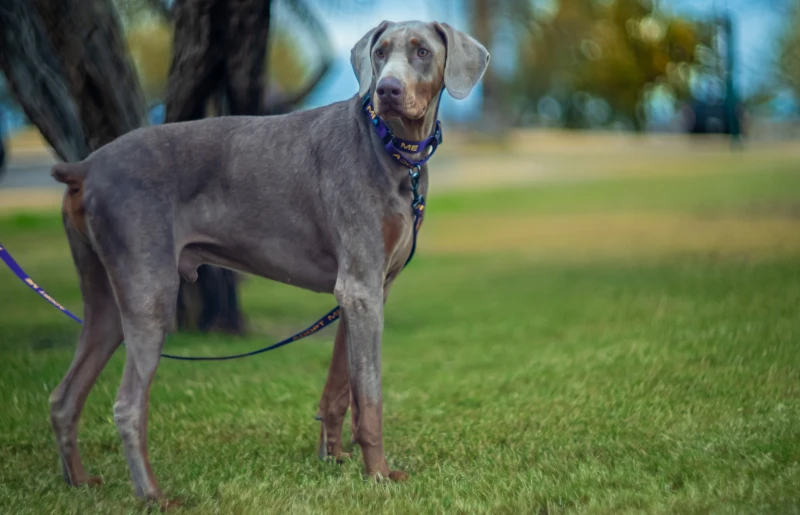Irish Wolfadoodle: Pictures, Care Guide, Temperament & Traits
Updated on

Click to Skip Ahead
The Irish Wolfadoodle is a mix between the Irish Wolfhound and the Poodle. This mixed breed is pretty rare—unlike some other mixed breeds available today. While they can vary a lot, they are generally known for being very intelligent and gentle.
They may be low-shedding, but others may shed quite a bit. It all depends on the traits they inherit from their parents.
Breed Overview
| Height: | 25–26 inches |
| Weight: | 60–90 pounds |
| Lifespan: | 8–12 years |
| Colors: | Cream, black, brown, gray, etc. |
| Suitable for: | Families with plenty of space |
| Temperament: | Affectionate, loyal, intelligent |
As you might expect, these dogs are huge. Therefore, they often work best in homes with plenty of room. They may also be a bit more on the active side, which makes their large size an even more important consideration. They often require moderate maintenance, as well.
These dogs don’t tend to shed much, but that doesn’t mean they don’t shed at all. They also aren’t hypoallergenic, like some advertisements may lead you to believe. Therefore, don’t assume these dogs will be good for your allergies.
Irish Wolfadoodle Breed Characteristics
Irish Wolfadoodle Puppies
Because they are a mixed breed, you’ll never know exactly how a puppy Irish Wolfadoodle will act. They’re exceptionally active and very lovable. They grow very fast, though it may still take them over a year to reach their adult size. Very quickly, they become massive dogs, so don’t be fooled by the small size of puppies.
Often, these dogs are affectionate and social, even as puppies. Still, it’s important to socialize them well and often. They can be hard to control due to their massive size, so socialization and training become even more important.
Finding Irish Wolfadoodle puppies can be a bit more challenging than some other breeds due to their relatively low numbers and the necessity of responsible breeding practices. Irish wolfhounds are rare, which makes any puppies made from them also rare. It’s important to consider the quality of the breed, too, as these dogs must have an even temperament.

Temperament & Intelligence of the Irish Wolfadoodle
These dogs tend to have a temperament that consists of traits from their Irish Wolfhound parent and traits from their poodle parent. Exactly what traits your dog will inherit depends completely on chance.
Usually, these dogs are friendly and affectionate. They’re often pretty good with children, which means that they may make great family dogs. In many cases, they are calm and easygoing, though some may be more uptight. They’re also very intelligent, usually making them easier to train. They also require more mental stimulation to prevent boredom, though.
Often, these dogs form very strong bonds with their owners. They’re loyal and protective, though they don’t necessarily make good guard dogs. They’re simply too friendly to be much use in that department. Still, because of their large size, just having one tends to make criminals think twice.
Be sure you’re prepared for some variety and unknown in your dog’s breed, though.
Are These Dogs Good for Families? 👪
In many cases, these dogs can be good with families. They’re often friendly and social, which allows them to get along with just about anyone. They also don’t tend to be very aggressive—an important consideration when you have kids.
If your kids are more active, this dog is often active enough to keep up with them. However, they don’t tend to be hyperactive, unlike some other breeds.
That said, these dogs require proper training and socialization to become well-adapted members of the family. This process takes time and patience, so it’s important to consider if you have the time and patience to give them.
Furthermore, they can be exceptionally large. It’s important to figure out if you truly have the space for them.
Does This Breed Get Along with Other Pets?
Irish Wolfadoodles will generally get along with other pets. They do have a bit of a prey drive, though, which may make them a problem for other pets. Plus, they’re also very large, which means that they can cause accidental injuries pretty easily. With proper socialization, they can often get along with others, though.
Early socialization is key to making this happen, though. It’s important that these dogs are introduced to animals early on to help them get used to the idea of other pets not being food. As always, monitor their interaction well, as there can be a lot of individual variances going on.
Some Irish Wolfadoodles may have a higher prey drive than others. Unfortunately, they may never get along with other pets, as it is almost impossible to overcome these instincts.
Things to Know When Owning an Irish Wolfadoodle
Food & Diet Requirements 🦴
As you might guess, these dogs eat a lot of food. Therefore, you’ll probably need to consider your budget, even if you aren’t typically used to paying attention to the price of dog food. Still, we recommend feeding your dog the best food you can afford. Look for food that contains meat as the first ingredient. This meat should be named “beef” or “chicken.”
You’ll probably want to choose a large-breed formula, as well. These dogs can be prone to hip dysplasia, and this is partially caused by diet. Giant-breed formulas have the necessary nutrition your dog needs, which may be different from what a much smaller dog breed needs.
Establish a regular feeding schedule and keep your dog on it as much as possible. Irish Wolfadoodles do well with two meals a day in most cases. However, very young puppies may need three. Of course, all dogs should also have clean water whenever possible.
Be mindful of the number of treats your dog has. Don’t use excessive numbers of treats, as this can cause weight gain (which is also linked with hip dysplasia).
Exercise 🐕
While these dogs are not extremely active, they still require some amount of daily exercise. Because they are so large, this exercise needs to be done outside. Unlike some smaller breeds, you won’t be able to get their energy out with a quick game of tug-of-war indoors. Aim for at least 30 minutes a day.
That said, you really have to follow your dog’s temperament and behaviors when it comes to exercise. Overexercising very large dogs can cause joint issues, especially when they are younger. Therefore, puppies should not be forced to walk a certain distance. Often, fetch and similar active playtime should consist of most of their exercise, as they are free to stop at any time.
Engage them in play sessions, such as fetch or tug-of-war. This helps keep them mentally stimulated, too. You can also play more mentally draining games like “hide and seek,” especially if your dog is on the more intelligent side.
As always, be sure to monitor them for obesity. If your dog seems to be gaining extra weight, we highly recommend talking with your vet about potentially adjusting their feeding and exercise schedule.
Training 🎾
These dogs are pretty smart, so they do require some amount of daily training for mental stimulation. Plus, because they are so large, training is necessary for your dog to work well inside a home. Begin training as soon as you bring your dog home. Early training is much easier than training later. Plus, these dogs grow very quickly.
Be very consistent in your techniques and rules. Make sure everyone in the house follows suit. This will make the training easier, as the dog will pick up on the cues faster. Be sure everyone knows the names of the commands you wish to use and uses the same ones.
Grooming ✂️
These dogs require some regular maintenance. However, how their grooming works will depend largely on the traits they inherit from their parents. Each dog may have a slightly different coat since their parents have different coats.
Irish Wolfadoodles often need their coat brushed 2 to 3 times a week, though they may need it brushed more if they are particularly prone to matting. You should not have to bathe them all that much. Every 6 to 8 weeks is fine. Be sure to use a dog-specific shampoo to maintain their skin’s natural oils, as they may develop skin issues otherwise.
Their coat likely needs to be trimmed to a decent length that you can manage. Their face, paws, and ears particularly need to be trimmed, even if you leave the rest of their coat natural. Professional grooming is often recommended.
Ear cleaning is highly recommended to prevent infection, which is why we also recommend trimming the inside of their ears. Nail care is vital, and you should plan to have their nails trimmed about once a month. Overgrown nails are very uncomfortable and can even cause more serious issues.
Be sure to brush your dog’s teeth regularly to prevent infections. Use a vet-approved ear cleaner and avoid pushing dirt into the ear canal. Instead, just clean the outer part of the ear. If you notice any redness or a strange smell, call your vet right away.
Health and Conditions 🏥
Like all breeds, these dogs can be prone to some medical issues. Often, this is related to their weight, not a specific genetic issue.
- Eye infection
- Ear infections
- Obesity
- Gastric torsion
- Hip dysplasia
- Dilated cardiomyopathy
- Hypothyroidism
Male vs. Female
There are not any serious differences between the males and females in this breed. Sometimes, males are bigger than females. However, this breed varies so much that this isn’t always the case. Very small males and very small females are much more common than in purebred dogs.
3 Little-Known Facts About the Irish Wolfadoodle
1. They aren’t hypoallergenic.
Some people mistakenly believe that doodle mixes are hypoallergenic. However, as we explained in the intro, these dogs are not truly hypoallergenic.
2. Their coats may not be curly.
You often see these dogs advertised with curly coats, but this isn’t always the case. Some may not have curly coats at all. You likely won’t know your dog’s coat type until they get older.
3. They may not be big.
While these dogs can get large, their size also varies considerably. In some cases, these dogs may inherit smaller genes from their Poodle parent.
Final Thoughts
These massive dogs can make great family pets if you approach their care properly. They need plenty of training and socialization on top of their grooming needs. They’re also moderately active, and they must be exercised outside due to their large size. If you can care for one of these dogs, they can be very good pets, but you do need to ensure that you can care for one of them before deciding to adopt one.
You should also plan on your dog varying at least a little bit. These canines are a mixed breed, which means that the traits they inherit tend to vary widely.
See also:
- Irish Setter Lab Mix: Pictures, Care Guide, Temperament & Traits
- Irish Setter Cocker Spaniel Mix: Pictures, Care Guide, Temperament & Traits
Featured Image Credit: (L) GoDog Photo, Shutterstock | (R) FotograFre, Shutterstock














